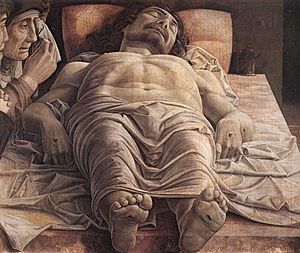- Lamentation of Christ (Mantegna)
-
The Lamentation over the Dead Christ 
Artist Andrea Mantegna Year c. 1480 Type Tempera on canvas Dimensions 68 cm × 81 cm (27 in × 32 in) Location Pinacoteca di Brera, Milan The Lamentation of Christ (also known as the Lamentation of Dead Christ, or the Dead Christ) is a c. 1480 painting by the Italian Renaissance artist Andrea Mantegna. While the dating of the piece is debated, is generally believed to have been completed between 1475 and 1501.[1] It portrays the body Christ supine on a marble slab. He is watched over by the Virgin Mary, St. John and somebody in the upper left hand corner just behind Virgin Mary who are weeping for his death.
The theme of the Lamentation is common in medieval and Renaissance art, although this treatment, dating back to a subject known as the Anointing of Christ is unusual for the period. Most Lamentations show much more contact between the mourners and the body. Rich contrasts of light and shadow abound, infused by a profound sense of pathos. The realism and tragedy of the scene are enhanced by the violent perspective, which foreshortens and dramatizes the recumbent figure, stressing the anatomical details: in particular, Christ's thorax. The holes in Christ's hands and feet, as well as the faces of the two mourners, are portrayed without any concession to idealism or rhetoric. The sharply drawn drapery which covers the corpse contributes to the dramatic effect. Unique to this painting is a design that places the central focus of the image on Christ's genitals - an artistic choice that is open to a multitude of interpretations. Mantegna managed instead to paint a very specific representation of physical and emotional trauma.
Mantegna presented both a harrowing study of a strongly foreshortened cadaver and an intensely poignant depiction of a biblical tragedy. This painting is one of many examples of the artist's mastery of perspective. At first glance, the painting seems to be a strikingly realistic study in foreshortening . However, careful scrutiny reveals that Mantegna reduced the size of the figure's feet, which, as he must have known, would cover much of the body if properly represented.[2]
Mantegna probably made this painting for his personal funerary chapel. It was found by his sons in his studio after his death and sold off to pay debts. The painting is in the Pinacoteca di Brera of Milan, Italy.
Notes
- ^ Mantegna, Andrea. Web Gallery of Art. Retrieved June 14, 2009.
- ^ Kleiner, Fred S. Gardner's Art Through the Ages, 13th edition.
Sources
- La Grande Storia dell'Arte - Il Quattrocento, Il Sole 24 Ore, 2005
- Kleiner, Frank S. Gardner's Art Through the Ages, 13th Edition, 2008
- Manca, Joseph. Andrea Mantegna and the Italian Renaissance, 2006
Works by Andrea Mantegna Ovetari Chapel (1448–1457) · The Adoration of the Shepherds (c. 1450–1451) · St. Jerome in the Wilderness (c. 1451) · San Luca Altarpiece (1453) · St. James Led to His Execution (c. 1455) · Presentation at the Temple (c. 1455) · Crucifixion (1459) · Agony in the Garden (c. 1459) · Portrait of Cardinal Ludovico Trevisan (c. 1459-1460) · St. Bernardino of Siena between Two Angels (1460) · Death of the Virgin (c. 1461) · Portrait of a Man (c. 1460) · Portrait of Francesco Gonzaga (c. 1461) · Madonna with Sleeping Child (c. 1470) · St. George (c. 1460) · San Zeno Altarpiece (1460) · St. Sebastian (of Vienna) (c. 1459) · Adoration of the Magi (1462) · The Ascension (1462) · The Circumcision (1464) · Portrait of Carlo de' Medici (c. 1459-1466) · St. Sebastian (of the Louvre) (c. 1480 · The Madonna of the Cherubim (c. 1485) · Triumphs of Caesar (c. 1486) · Christ as the Suffering Redeemer (c. 1488-1500) · Lamentation over the Dead Christ (c. 1490) · Madonna of the Quarry (1490) · St. Sebastian (of Venice) (1490) · Madonna della Vittoria (1496) · Judith and Holofernes (1495) · Trivulzio Madonna (1497) · Parnassus (Mars and Venus) (1497) · Holy Family (c. 1500) · Triumph of the Virtues (c. 1502)Categories:- 1480s paintings
- Mantegna paintings
- Collections of Pinacoteca di Brera
- Paintings depicting Jesus
- Paintings depicting death
- Christian death-related art
Wikimedia Foundation. 2010.
